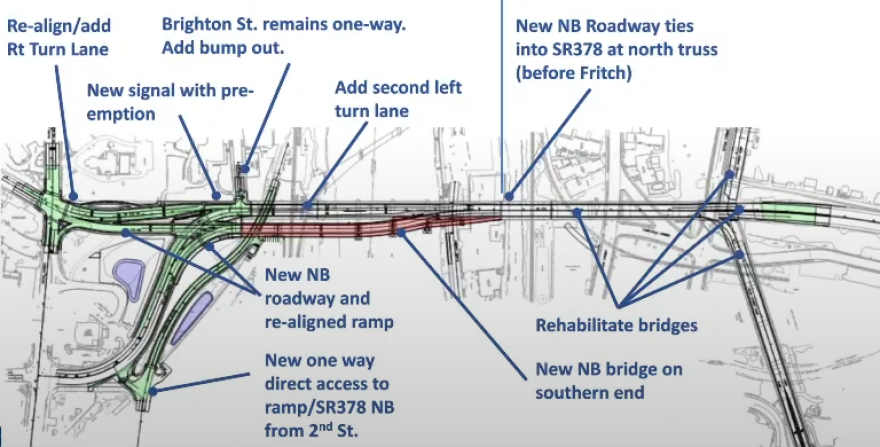BETHLEHEM, Pa. — Planners at the Lehigh Valley Transportation Study on Wednesday heard an update on the massive restoration and upgrade project planned for the Hill-to-Hill Bridge.
The 100-year-old bridge hosts the often-congested state Route 378 and carries vehicles and pedestrians over the Lehigh River, railways, trails and city streets to connect Bethlehem's north and south sides. It also provides direct connectivity to U.S. Route 22 and state Route 309.
It has undergone various changes and updates since its completion, such as introducing the expressway connecting to Route 22 and removing some ramps included in the original construction.
To revive the aging structure and attempt to alleviate the consistent trend of traffic backups at the south entrance of the bridge, PennDOT is plotting a significant rehabilitation project in the coming years.
PennDOT said about $69 million is secured for the project, with the City of Bethlehem assisting in funding the improvements on the bridge's city-owned structures at a cost of about $8 million.
The total cost is estimated at $78 million, but that number is not finalized as analyses on the structure continue.
On the most recent transportation improvement program adopted by regional planners, the project is set to receive $56 million over the next four years, along with another $2 million for upgraded lighting.
Bids on the project are expected to open within the following fiscal year with construction hoped to begin in 2026 and expected to take about four years.
Balancing historic landmarks with improvement
A presentation delivered by Brian Teles, a PennDOT consultant project manager, gave the LVTS an update on the status of the project, which has been planned for years.
"We're trying to minimize the historic impacts of this as best we can."Brian Teles
He said a revitalization is a unique challenge given that the bridge carries more than 55,000 vehicles per day while intersecting over historic and public areas. The bridge is also considered a historic landmark itself.
"We're trying to minimize the historic impacts of this as best we can," Teles said.
"Just about everything is historic around here. So it's it's a very interesting project. It's unique in the sense that it's not just one corner of a project that's historic — pretty much everything is historic. So it is a balancing act as to meeting today's needs and trying to preserve the history of this bridge at the area too."

Aside from increasing the structure's lifespan, Teles noted congestion as a main concern for the project. He specifically noted that EMS access to nearby St. Luke's Hospital on Ostrum Street in Fountain Hill's level 1 trauma center as a motivator to improve congestion.
"This project is not going to solve all the traffic woes in the entire area around here, but we're trying to alleviate it ... as much as we can," Teles said.
"We're doing as best we can to allow EMS to come through this area, because they do struggle today."
Next steps include further analysis and continued coordination with nearby stakeholders before pursuing official bids on the project.
Project set to change the bridge's south entrance
Outlining the project, transportation study members were shown slides on the resources surrounding the existing structure, and what is proposed to be changed.
A second left turn lane southbound on 378 would be added to reduce congestion as cars enter south Bethlehem.
This would be done by widening the existing bridge, essentially adding a parallel road exclusively for northbound traffic on the southern portion of the structure.
Existing rampways will also be realigned while also working to "smooth out" the intersection with Third Street.
A one-way direct access ramp northbound to the bridge from Second Street is also proposed to eliminate bottlenecks on Third Street and Wyandotte Street, giving a different access point.
Both existing trusses are to be preserved.
Traffic signals and pedestrian crossing improvements at the south entrance to the bridge are also planned, Teles said.

The bridge is planned to remain four lanes during construction "as much as we possibly can," in part by doing work overnight and on weekends.
He says signage is also to be improved to better communicate the transition from freeway to city grid upon exiting the bridge on the south side of the city.
Potential improvements include preservation work on the main street ramp, and a potential exit onto Second Street.
To develop the project, PennDOT officials has held meetings with various local stakeholders, they say, including the City of Bethlehem, Fountain Hill Borough, Lehigh University, St. Luke's and ArtsQuest.
Pedestrian connectivity to be improved, but faces limitations
Some concern was pointed out regarding multimodal improvements to the bridge, given that the eastern and western sidewalks of the bridge connect South Bethlehem's pedestrians and cyclists to different portions of the city — with those coming from Fountain Hill being directed to West Bethlehem and those coming from the direction of Third Street being directed to Main Street with no ability to directly cross to the other side while on the bridge.
Scott Slingerland, executive director of the Lehigh Valley Coalition for Appropriate Transportation, said the project could have the opportunity to connect South Bethlehem's Greenway project to the D&L trail. He argued that this could be done for a "relatively small percentage of the project budget."
He said that the current six-foot sidewalks are insufficient for proper bike and pedestrian connectivity, and hopes that the sidewalks could be extended.
Teles said there are limitations to the modification they can do without disturbing the footprint off the bridge, but that the sidewalk on the new portion of the bridge is planned to be expanded and the new Second Street ramp may provide a future connection between the two trails.
He also said pedestrian islands and improved signaling for pedestrians at the South entrance to the bridge were also planned.
"We're trying to balance it and figure out, as best we can, to improve it. But we have been paying attention to those things," Teles said.


